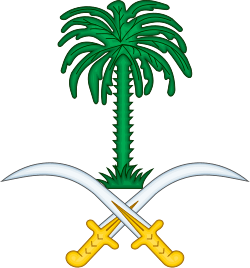Transport in Saudi Arabia
With the arrival of petrodollars, the Kingdom of Saudi Arabia has initiated many mega infrastructure development projects in the country, and the extensive development of the transportation network has followed suit in support of various economic developments. As a result, the country now boasts an extensive transportation network.
Road transportation
Total: 221,372 km (137,554 mi)
Paved: 47,529 km (29,533 mi) (includes 3,891 km (2,418 mi) of expressways)
Unpaved: 173,843 km (108,021 mi) (as of 2006)
Roads in Saudi Arabia vary from eight-laned roads to small two-lane roads in rural areas. The city highways and other major highways are well maintained, especially the roads in the capital Riyadh. The roads have been constructed to resist the consistently high temperatures and do not reflect the strong sunshine. The other city highways such as the one linking coast to coast are not as great as the inner-city highways but the government is now working on rebuilding those roads. In October 2013, a group of auto enthusiasts drove some 2,000 km (1,200 mi) through Saudi Arabia in search of the best driving road, and named the Jeddah-Taif-Al-Hada highway as "motoring nirvana".[1]
Saudi Arabia had encouraged road transport in the past as had it maintained one of the lowest petrol prices in the world, at $0.13 per litre. In 2018, this price was raised to about $0.54 per litre, which is still not that high global-wise but definitely the highest it had ever been in the oil producing kingdom.[2]
Some of the important inter-city highways include the following:[3][4]
- Dammam - Abu Hadriya - Ras Tanura Highway 257 km (160 mi)
- Khaybar - Al Ola Highway 175 km (109 mi)
- Mecca - Madinah Al Munawarah Highway 421 km (262 mi)
- Riyadh - Dammam Highway 383 km (238 mi)
- Riyadh - Sudair - Al Qasim Highway 317 km (197 mi)
- Riyadh - Taif Highway 750 km (470 mi)
- Taif - Abha - Jizan Highway 750 km (470 mi)
- Medina - Tabuk Highway 680 km (420 mi)
- Jeddah - Al Leith - Jizan Highway 775 km (482 mi)
- Jeddah - Mecca Highway 80 km (50 mi)
On 19 February 2018, it was announced that four of the main Saudi motorways that allow for high speed will grant a speed limit increase to users from 120 kmph to 140 kmph. Those motorways are (Mecca-Medina), (Riyadh-Dammam), (Riyadh-Gassim) and finally (Riyadh-Taif).[5]
Sea transportation
Saudi Arabia has a well development sea transport network developed primarily to support the transport of petrochemicals. Saudi Ports Authority is the ports management organization in the country, overseeing the operations.
The major ports in the country are as follows;
Persian Gulf
- King Abdul Aziz Port, Dammam
- Jubail
- Ras Tanura
- Khafji
- Khobar
- Ras Al-Zour (under construction)
Red Sea
Air transportation
There are an estimated 203 airports in Saudi Arabia (2003 est.).
Airports with paved runways
total:
61
over 3,047 m:
32
2,438 to 3,047 m:
13
1,524 to 2,437 m:
12
914 to 1,523 m:
2
under 914 m:
2 (2003 est.)
Airports with unpaved runways
total:
133
over 3047 m:
6
2,438 to 3,047 m:
5
1,524 to 2,437 m:
75
914 to 1,523 m:
38
under 914 m:
14 (2003 est.)
Heliports
9 (2009 est.)
Rail transport

As a result of over-reliance on road and air travel, the rail transport has not received a similar level of investment in Saudi Arabia. However, there are now plans for expansion within the kingdom's railway infrastructure. Some of these plans are:
- The Saudi Landbridge Project is a project that aims to link the port cities of Jeddah, Dammam, and Jubail. It will also pass through Riyadh and serve its dry port. The line linking Riyadh and Jeddah is planned to be approximately 950 km (590 mi) long, whilst the line connecting the two cities of Dammam and Jubail should be around 150 km (93 mi). [6]
- The Haramain High Speed Rail Project (HHR) underway in the Western province, connecting Makkah with Jeddah and Madinah city with a 453 km (281 mi) long railway line. This semi-electric passenger double line will be created to transport the large number of Hajj pilgrims, which the SRO considers transportation for, an urgent matter. It will be up and running by May 2018.[7]
- The Al Mashaaer Al Mugaddassah Metro Southern Line is part of the Makkah Metro rail transit system, which was developed in Makkah city. This is a 18.1 kilometers (11.2 miles) track developed as exclusive shuttle a predicted 8 million pilgrims between Mecca, Mount Arafat, Muzdalifa and Mina on the annual Hajj pilgrimage.
- The Riyadh Metro is a 6 line rapid transit system under construction in the capital. As of April 2018, it is 71% completed. It is scheduled for a soft opening in 2019, the full network is expected to be fully operational by 2021.
References
- ↑ "McLaren 12C. Saudi Arabia. The Hidden Kingdom - crankandpiston.com". crankandpiston.com. 21 October 2013.
- ↑ "Saudi Gazette".
- ↑ http://saudinf.com/main/g11.htm Saudi inter-city highways
- ↑ www.saudia-online.com, Hadi Bahra;HDC- Horizon for Commercial Development Co.,Ltd,. "THE ROADS AND PORTS SECTORS IN THE KINGDOM OF SAUDI ARABIA". www.saudia-online.com.
- ↑ "Arab News".
- ↑ "Landbridge Project", Saudi Railways Organization. Retrieved on 17 August 2017
- ↑ "[Haramain Project Brief"], Saudi Railways Organization. Retrieved on 17 August 2017.
